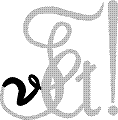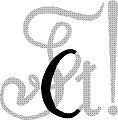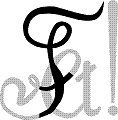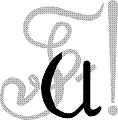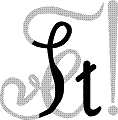Circle (student union)
The circle is a monogram-like identifier of a student union . It is an intertwining of letters , usually written in one go , usually the first letter of the connection name and a motto. This motto is not always to be equated with the motto of the connection. In the past, circles formed from the first letters of the university name were also common at some universities, such as F and A for Friderico-Alexandrina , G and A for Georgia-Augusta or R and C for Ruperto-Carola .
history
Circles first became naturalized around 1780 with the student orders and were quickly adopted by the later corps .
At first it was just a series of initial letters in the form of an abbreviation, later the "artificially entwined", "mysterious" composition of the same became from this.
Until the early 19th century, compasses consisted only of such letter combinations; the exclamation mark behind the circle did not appear until between 1820 and 1830.
Meanings of the circle

The circle usually has the first letter of the connection name and a motto. Common variants of the motto are:
- Vivant fratres coniuncti <connection name (in the genitive ); z. B .: Guestphaliae> : Let the connected brothers live
- Vivat circulus fratrum <connection name (in the genitive plural); z. B .: Hassorum> : Long live the circle of brothers
- Vivat, crescat, floreat <connection name; z. E.g. Germania> : Long live, grow, bloom
From 1795 "Vivat circulus fratrum ..." replaced the previously common meaning "Vivant fratres coniuncti ...".
- Breakdown of the individual components using the example of the WKSt.V. Unitas Stolzenfels
The use of the compass



- Corporates put the circle after the signature as an addition to their name when they do this in "corporation matters". If you belong to several connections, these circles will be added after the signature in the order in which they joined. For black connections , i.e. H. Connections that neither bear colors nor carry colors, the circle is often the only distinguishing mark of the connection. Some connections created by mergers of two or more predecessor connections also lead more than one circle.
- Charged persons put a charge symbol in the form of crosses behind the circle ("×", "×phia", "×habenoons"). A fox major often puts an FM behind the circle, the foxes with some connections the addition F or ren for Renonce , connoisseurs a CK .
- In typewriter typesetting , the circle is often replaced by “Z!”, And in some connections also by other letters or letter combinations with exclamation marks. Due to the possibilities of the computer, circular graphics are increasingly used for official writing of a connection, which show the connection affiliation of the person concerned.
- The circle is also used on couleur objects , such as glasses, jugs, flags, sometimes also as embroidery on hats, in particular the so-called beer bins (see also: Studentica ) .
- Examples of circles can be examined in detention centers (former university prisons), for example in Heidelberg , Erlangen , Göttingen , Greifswald and Leipzig .
- Compasses on utensils
The exclamation mark
The exclamation mark did not appear behind the entwined letters of the circle until between 1820 and 1830.
Most likely the exclamation mark relates to the imperative aspect of the vivat! as an option . This explains the occasional addition of three exclamation marks after the circle up to around 1850, as this is based on the triple wish of Vivat! Crescat! Floreat! Respectively.
There are also other interpretations, which, however, are not documented as later interpretations. Some claim that the exclamation mark symbolizes the principle of unconditional satisfaction with the weapon; At the beginning of the 19th century, however, the (more or less abstract) sign of the crossed racket pointing upwards is common.
Others are of the opinion that the callsign is a sign that the connection is still active, or that it symbolizes the old rule as a line and the activitas as a point. Frets without active operation should therefore be recognizable by the absence of the exclamation mark or point, which is not the case in practice. In addition, there are organized old rulers , to which the stroke of the call sign could refer, only since the second half of the 19th century. Such meanings are ascribed to the exclamation mark especially in relatively young connections.
Circle of the Corps Hannovera Heidelberg (1810–1813) - still without an exclamation mark
Circle of Corps Hassia Giessen with three exclamation marks (probably mid-19th century)
See also
literature
- Werner Barthold : The symbols of the student corps . In: Deutsche Corpszeitung 5, 1974, ISSN 0931-0215 , p. 208.
- Erich Bauer : Schimmer book for young corps students . 4th edition. Self-published by the Association of Old Corps Students, Bonn 1971, p. 15.
- Rolf-Joachim Baum: Thoughts on the Circle. Secret sign, monogram, symbol . In: then and now. Yearbook of the Association for Corporate Student History Research 30, 1978, ISSN 0420-8870 , pp. 156-161.
- Aribert Schwenke: Symbols, emblems and secret signs in the Kösener corps coat of arms. In: then and now. 41, 1996, pp. 29-82.
Web links
Individual evidence
- ^ Paul Wentzcke : History of the German Burschenschaft. Vol. 1. Early and early times up to the Karlovy Vary resolutions. Heidelberg 1965. ISBN 3-8253-1338-7 . P. 32.
- ↑ a b Peter Kaupp: Freemasonry and Boy Customs. Continuity of religious traditions in corporate students . In: Bernhard Schröter (Hrsg.): Festschrift for the fraternity and student historian Prof. (FH) Dr. Peter Kaupp. 2006. pp. 188-230, here p. 223.
- ^ A b Wilhelm Fabricius : The German Corps: a historical representation with special consideration of the scale system. Thilo, 1898. p. 341.
- ↑ Werner Helmut Stahl: Frankfurt brands & characters . Strothotte, Frankfurt am Main 2004. p. 63.
- ↑ a b Peter Kayser, Niels Lange: 50 years of the order of the Heyligen Frawe Latte in Hanover / ad Hammaburg. A chronicle. Seaport, Hamburg 2002. p. 19.

